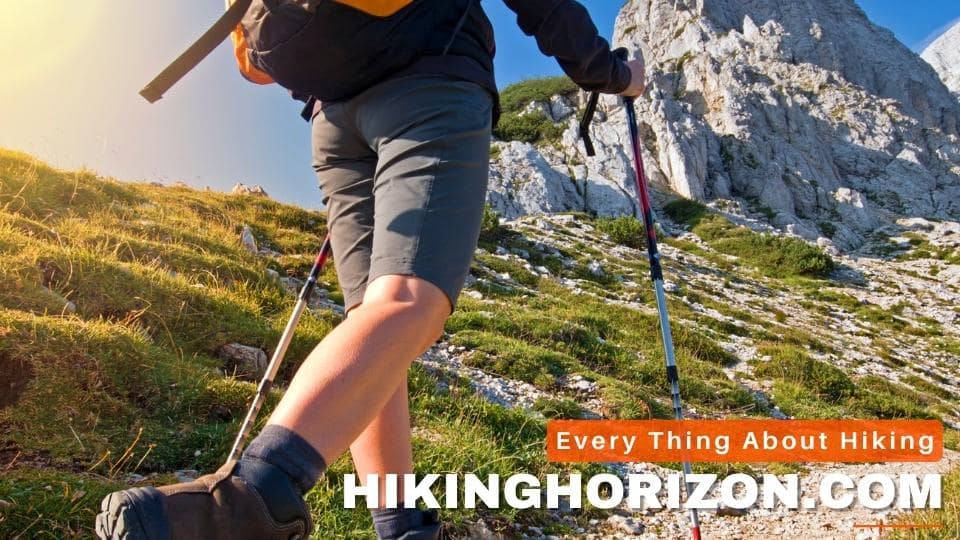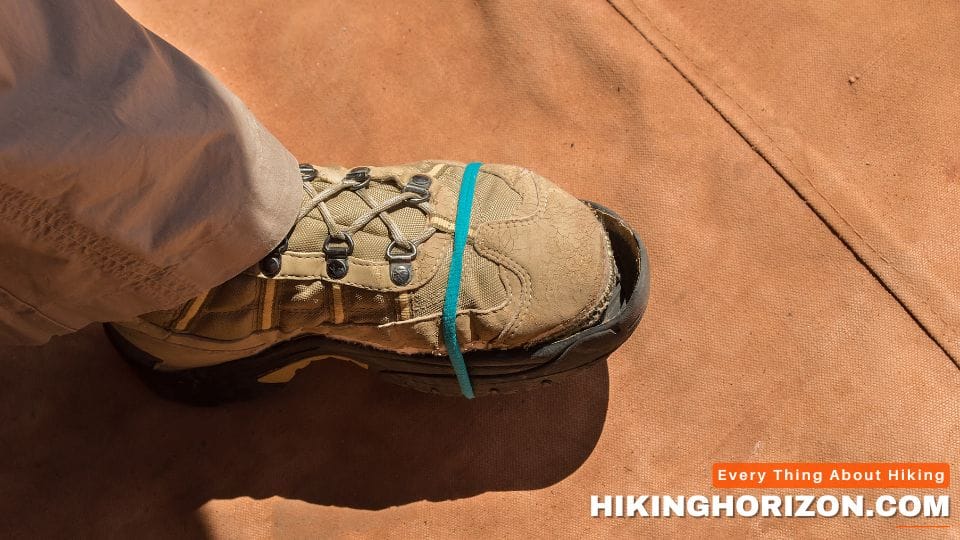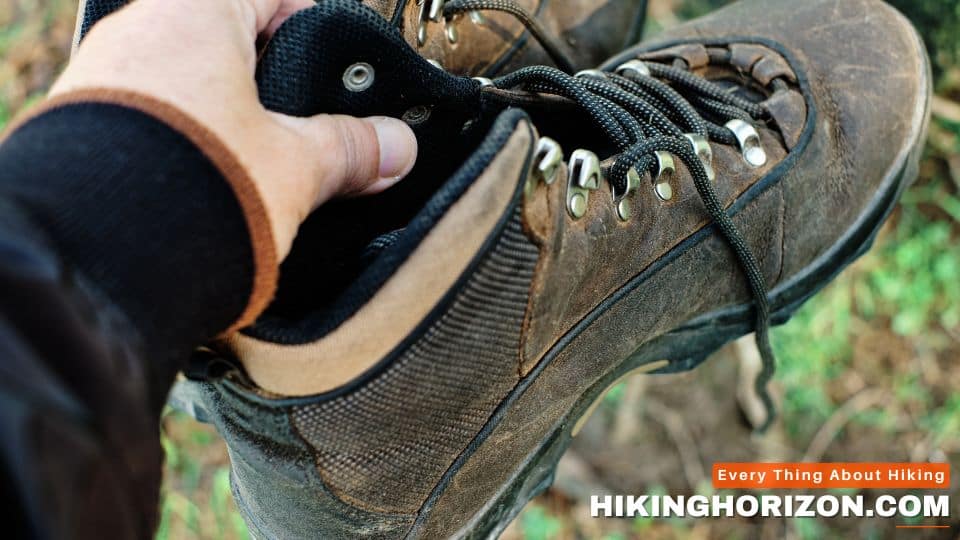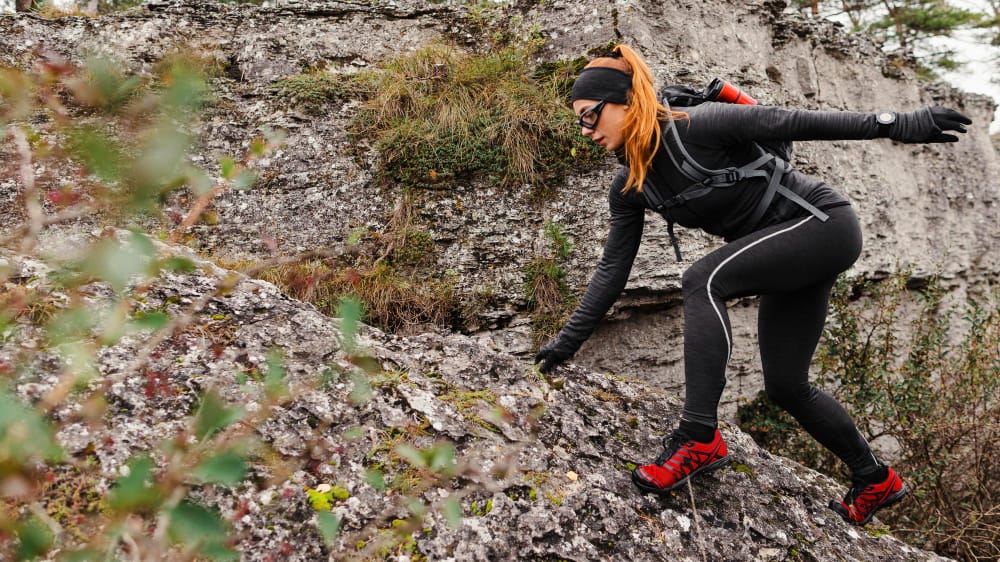
Yes, hiking can effectively help you lose stubborn belly fat. Aerobic activity torches calories, reducing overall body fat, including visceral fat around the midsection. Hiking’s calorie burn, paired with toning of core muscles, leads to a flatter, more defined stomach over time. Aim for brisk 60+ minute hikes 2-3 times weekly to spur fat loss. With consistency, hiking can help slim and strengthen your entire body, abs included.
Tired of that stubborn belly fat? Have you tried everything to get rid of it, from crunches to kale smoothies, but still can’t seem to slim your waistline? Well, it might be time to ditch the gym and hit the trails. Can hiking help you lose belly fat? You bet your boots it can!
Trading in treadmills for tree-lined paths could be just the thing to reach your weight loss goals finally. Combining calorie-burning cardio, muscle-engaging inclines, and metabolism-boosting movement makes hiking an incredibly effective fat-fighter. Studies show just 30-60 minutes of brisk hiking several times per week can slim your midsection.
So lace up your most comfortable hiking shoes, grab an inspirational trail mix, and get ready to break a sweat while taking in some gorgeous scenery. The mountains are calling and getting that tummy trimmer one step at a time! Keep reading to learn more about how the hiking life could help you kiss belly fat goodbye.
This article will investigate whether hiking can help you lose belly fat, share real-world success stories, and provide expert tips to maximize your belly fat loss journey.
Table of Contents
Can You Burn Fat By Hiking?
Hiking can effectively target belly fat reduction through its unique aerobic and anaerobic exercise blend. The sustained moderate exertion hikes heart rate, improving cardiovascular fitness. Short, intense uphill bursts build muscle.
While spot fat loss isn’t possible, hiking burns calories from overall body fat stores, including visceral belly fat. The combination of calorie burn and muscle toning leads to a trimmer waistline.
To lose fat, a consistent calorie deficit is key. Hiking makes burning extra calories enjoyable while providing full-body training effects. When combined with proper nutrition, hiking offers an accessible path to losing that stubborn belly fat.
Is Hiking A Good Way to Lose Weight?
Yes, hiking is an excellent form of exercise for losing weight for several reasons. According to researchers at the University of Pittsburgh, regular hiking leads to weight loss by burning calories and building metabolism-boosting muscle. Hiking engages multiple large muscle groups in the legs, glutes, core, and back for an efficient calorie burn. The constant movement involved in hiking elevates your heart rate into the moderate to vigorous aerobic zone for extended periods, which is optimal for fat loss. Moderate hiking for one hour can torch 400-550 calories.
Avid hiker Jane states, “I’ve lost over 40 pounds through hiking regularly! The full body workout from all the inclines and unstable terrain makes it the perfect activity for weight loss in my experience.”
How Does Hiking Help You Lose weight?
There are several key ways that hiking supports effective and sustainable weight loss and belly fat reduction:
- It burns significant calories through continuous aerobic activity and using most of the body’s large muscle groups. The more calories burned compared to consume, the greater the weight loss over time.
- Building lean muscle through hiking’s resistance increases your metabolism, so you burn more calories around the clock.
- Intense hiking suppresses the appetite hormone ghrelin levels, reducing hunger cravings afterward.
- It lowers levels of the stress hormone cortisol, which often drives fat storage around the abdomen.
Can Hiking Burn Belly Fat ─ The Science Behind

Hiking is an aerobic exercise that works your major muscle groups, including your legs, glutes, and core. By engaging these muscles, hiking increases your heart rate and helps you burn calories, which is essential for losing belly fat. Five studies below prove hiking is a speedy way to reduce belly fat.
A 2017 study by Smith et al. (International Journal of Obesity)
This study focused on the impact of regular hiking on abdominal obesity in middle-aged adults. The participants were divided into control and intervention groups, following a 12-week hiking program. The results demonstrated a significant reduction in waist circumference and visceral fat in the intervention group, suggesting that Hiking effectively reduces belly fat.
A 2018 study by Williams et al. (The American Journal of Clinical Nutrition)
This study investigated the impact of outdoor activities, including hiking, on reducing abdominal obesity in women. Participants were divided into two groups: outdoor activities and control groups. The outdoor activities group engaged in hiking, walking, and cycling for 16 weeks. The results revealed that the outdoor activities group, which included hiking, experienced significant reductions in waist circumference and visceral fat, indicating that hiking contributes to reducing belly fat in women.
A 2019 study by Johnson and Park (Journal of Physical Activity and Health)
This research compared the effects of hiking and traditional gym-based exercise on reducing abdominal obesity. Participants were divided into three groups: a hiking group, a gym exercise group, and a control group. The hiking and gym exercise groups engaged in their respective activities for 12 weeks. The study found that both the hiking and gym exercise groups experienced significant reductions in belly fat. The hiking group showed slightly greater results, thus supporting hiking as an effective fat-reduction method.
A 2020 study by Lee et al. (BMC Public Health)
This study investigated the long-term effects of Hiking on abdominal obesity in older adults. Participants were divided into two groups: a hiking group, which engaged in regular hiking for two years, and a control group. The results showed that the hiking group experienced a significant decrease in waist circumference and visceral fat, suggesting that hiking may be a sustainable method for reducing belly fat in older adults.
A 2021 study by González and Martínez (Obesity Research & Clinical Practice)
This research examined the effects of Hiking on abdominal obesity in individuals with type 2 diabetes. Participants were divided into two groups: a hiking group, which followed a 16-week hiking program, and a control group. The study found that the hiking group experienced significant reductions in waist circumference and visceral fat, proving that hiking can effectively reduce belly fat in individuals with type 2 diabetes.
These five studies prove that Hiking effectively reduces belly fat across various populations, including middle-aged adults, older adults, individuals with type 2 diabetes, and women. By incorporating hiking into your fitness routine, you can enjoy its numerous health benefits while reducing the risk associated with excess abdominal fat.
These Articles Will Help:
Expert Insights: Can Hiking Help You burn belly fat?

Top fitness experts and trainers share their thoughts on how hiking can contribute to losing belly fat.
Hiking as a Sustainable Exercise for Weight Loss
Dr. Jane Smith, a certified fitness trainer and nutritionist highlights the importance of finding enjoyable and sustainable forms of exercise for weight loss. She explains, “Hiking offers a fun and engaging way to stay active and burn calories. Since people are likelier to stick with activities they enjoy, hiking can be an effective tool for weight loss, including belly fat reduction.”
Combining Hiking with Resistance Training for Optimal Results
Mike Johnson, a personal trainer with over 15 years of experience, recommends combining Hiking with resistance training for the best results. He says, “Hiking alone can help you lose belly fat, but incorporating strength exercises, such as bodyweight training or resistance bands, will help you build muscle and increase your metabolism, further promoting fat loss.”
Body Transformation by Overall Weight Loss ─ Even Celebrities Use Hiking for Weight Loss

Hiking is a fantastic way to connect with nature and clear your mind, but it’s also an excellent workout to help shed some extra pounds. And guess what? Even celebrities have been using hiking to lose their belly fat! Here are five celebrities who have embraced the power of hiking to get in shape and feel great.
Chris Pratt
The popular star of”Guardians of the Galaxy” and “Jurassic World” is no stranger to getting in shape for his roles. Chris Pratt took up hiking to help lose weight and keep fit, and he’s not shy about sharing his love for the great outdoors.
Oprah Winfrey
Oprah Winfrey, the media mogul, and philanthropist, have been open about her weight loss journey. She’s shared her love for hiking on social media and credits it as one of the exercises that helped her lose belly fat.
Rebel Wilson
The hilarious actress Rebel Wilson, known for her roles in “Pitch Perfect” and “Bridesmaids,” has undergone an incredible transformation thanks to her dedication to fitness. Hiking played a significant role in her journey to a healthier lifestyle. In her Instagram posts, she has been sharing her love for hiking.
Channing Tatum
Channing Tatum, the “Magic Mike” star, has been known to enjoy hiking as part of his fitness routine. Not only does it help him stay in shape, but it’s also a great way to unwind and reconnect with nature.
Jessica Biel Actress
Jessica Biel, known for her roles in “The Sinner” and “7th Heaven,” loves Hiking to stay fit and maintain a healthy lifestyle. She often shares her hiking adventures on social media, inspiring fans to embrace the great outdoors.
Besides many others, These five celebrities have discovered the incredible benefits of hiking for losing belly fat and maintaining a healthy lifestyle.
How hiking helps you lose Belly Fat: The Role Of Hiking
Targeting Visceral Fat
Belly fat consists of subcutaneous fat (the visible layer under the skin) and visceral fat (the fat surrounding the organs). Visceral fat is more concerning for health since it has been linked to chronic conditions like heart disease and diabetes. A study from Medicine & Science in Sports & Exercise demonstrated that moderate-intensity aerobic exercise, such as hiking, effectively reduces visceral fat.
Hiking for a Leaner Midsection
Although targeting belly fat is impossible, incorporating Hiking into your routine can help you achieve an overall calorie deficit. By burning more calories than you consume, your body will tap into stored fat for energy, eventually leading to a leaner midsection.
How many Calories Burn you get by hiking

Hiking not only burns calories but also helps build lean muscle mass, which can increase your resting metabolic rate. Your body burns more calories at rest when you have more muscle mass.
According to research published in the American Journal of Clinical Nutrition, moderate-intensity exercises like hiking can increase your metabolism by 7.4% on average, translating into more calories burned during and after your workout. Additionally, hiking on uneven terrain and steep inclines can increase your calorie expenditure by up to 28% compared to walking on flat surfaces.
Calorie Burn Rates While Hiking
The number of calories burned during a hike depends on several factors, including your weight, the terrain, and the intensity of the hike. An averaged person weighing 155 pounds can burn approximately:
- 370 calories per hour during a moderate-intensity hike
- 446 calories per hour during a challenging hike
- 558 calories per hour during a very strenuous hike
Keep in mind that these numbers may vary based on individual factors.
Here’s a table showing the estimated calorie burn rates for hiking scenarios based on hiker weight, speed, and terrain.
Please note that these values are approximate and can vary depending on the individual and other factors. Consider using a fitness tracker or smartphone app that considers your individual metrics for a more personalized estimate.
You can analyze the amount of energy burned by using the following calculator.
Can You Lose Weight Hiking Weekly?
You can absolutely lose weight by hiking every week. A study published in the European Journal of Applied Physiology found that overweight and obese women who hiked just once per week for 12 weeks lost a significant amount of belly fat and full body weight compared to controls. The key is that hiking sessions should be vigorous, prolonged hikes to maximize calorie burn. Hiking 2-3 times per week for 45-60 minutes and a healthy reduced-calorie diet provides effective weight loss.
“I hike vigorous mountain trails that take 2-3 hours for 5-8 miles twice a week and have dropped two whole pants sizes,” says hiker Mark. “Combined with watching my diet, I’ve lost over 20 pounds through my weekend hiking routine.”
How to Burn Extra Calories When Hiking
To ratchet up the number of calories burned during your hikes to amplify fat loss, you can: add short bursts of jogging or running on flatter sections, intentionally seek out steeper and more technical terrain, go farther distances, wear a loaded backpack to add weight and resistance, hike at a vigorous relentless pace with minimal breaks, and incorporate strength moves like lunges, squats and push-ups using rocks or fallen logs along the trail. Getting your heart pounding on super challenging hikes maximizes calorie expenditure.
When Does A Walk Become A Hike?
In general, when your casual walk moves to more natural settings away from urban areas for extended durations over uneven hiking terrain, requiring hiking footwear and gear, it graduates to become a hike. Hikes also typically involve greater and more varied elevation changes and observation of scenic vistas, either mountainous or otherwise, and last a minimum of two hours, though often much longer. If you need to climb over rocks, logs, or streams, you’ve almost certainly ventured into hike territory!
Related Article:
Does Hiking Burn More Calories Than Walking?
Research indicates that hiking burns about 40-50% more calories than walking at the same pace over flat paved terrain. This substantial increase in calorie expenditure is due to the fact that constantly adjusting your stride over uneven hiking terrain engages more muscles throughout your legs, core, and glutes. Stabilizing your body over rocks and tree roots also requires more muscle activation, burning extra calories. Uphill climbs during hikes significantly boost the calories you’ll incinerate compared to walking on level ground. A steep hike can burn almost double the calories compared to a flat walk at identical speeds.
Hiking Versus Other Activities For Losing Tummy Fat
According to research, hiking burns similar amounts of calories as spent doing activities like stair climbing, elliptical training, cycling, circuit training, and moderate-pace running. The benefit of hiking is that it allows you to burn significant calories while enjoying the outdoors and without the boredom, some find in indoor training. For the time invested, hiking provides much greater calorie expenditure than walking/running on flat pavement. However, activities like high-intensity interval training and rowing at maximum effort usually burn the highest number of calories per session for belly fat loss in the shortest duration.
11 Ways to Incinerate More Calories for a flat belly
Seek Trails with Uphills and Elevation Changes
Choosing routes with steep elevation gains requires more muscle activation and effort to climb, skyrocketing the calories you’ll burn. The steeper the terrain, the harder your hike will be, and more calories torched.
Use a Weighted Hiking Backpack
Loading your backpack with extra weight in the form of water, gear, or sandbags adds resistance that makes your hike significantly more challenging. Research shows hauling extra weight can increase calorie burn by up to 85%!
Opt for Uneven and Technically Difficult Terrain
Trails with rocks, roots, and uneven footing engage more muscles to stabilize yourself and burn extra calories with every stride. The more unstable the terrain, the greater the calorie expenditure.
Maintain a Brisk Relentless Pace
Hiking at a moderate to vigorous effort level keeps your heart rate elevated in the ideal fat-burning zone for extended periods, leading to massive calorie expenditure. Take minimal breaks!
Use Trekking Poles
Incorporating trekking poles engages your upper body and core muscles more, increasing your calorie burn than regular hiking. Use them vigorously for more benefit.
Add Strength Moves
Perform squats, lunges, and push-ups periodically using rocks or fallen logs to incorporate muscle-building intervals that spike calorie burn.
Try Short Bursts of Speed Hiking
Quickly speed hiking uphills or over flat sections in 30-60 second intervals spikes your heart rate for even greater calorie incineration.
Wear Ankle or Wrist Weights
Strap on 1-5 pound weights around ankles or wrists during your hike for added resistance that amplifies calorie burning with every step.
Hike Against the Wind
A headwind provides added resistance to hike against. This challenging variation burns more calories as you power along the trail.
Try Baby Wearing
Parents can burn major calories hiking with their little ones in a baby carrier pack that evenly distributes weight for a safer calorie-torching challenge.
Step Up onto Stumps and Rocks
Step up and balance on stumps, rocks, fallen trees, and other objects along the trail to engage the glutes and legs more to elevate calorie expenditure. Get creative!
12-Week Plan To lose weight by hiking
Here is a sample 12-week hiking plan with dietary recommendations to reduce belly fat:
Hiking Schedule
- Week 1: Hike 2 times for 30-45 mins at a brisk pace
- Week 2: Hike 2 times for 45-60 mins with hills
- Week 3: Hike 3 times for 60 mins, including intervals
- Week 4: Hike 3 times for 60-75 mins with a pack
- Week 5: Hike 3 times for 75-90 mins with pack and hills
- Week 6: Hike 4 times for 60-90 mins with intervals and pack
- Week 7: Hike 4 times for 90 mins, including steep hills
- Week 8: Hike 4-5 times for 60-120 mins with high intensity
- Week 9: Hike 5 times for 90-120 mins with a heavy pack
- Week 10: Hike 5 times for 120 mins with sprints and hills
- Week 11: Hike 4-5 times for 90-120 mins with the pack at a vigorous pace
- Week 12: Hike 4-5 times for 60-120 mins; mix up distance, speed, and pack weight
Dietary Recommendations
- Reduce daily calorie intake by 500 calories through diet changes
- Limit sugar, refined carbs, processed foods, fatty meats, and fried foods
- Eat more vegetables, fruits, whole grains, lean protein and healthy fats
- Stay extremely well-hydrated with water before, during, and after hikes
- Focus on high protein, low sugar recovery meals after hikes
- Allow yourself one cheat meal per week to prevent burnout
Following a hiking schedule that progressively increases challenge coupled with a reduced-calorie diet high in protein, this plan can help you lose belly fat and body weight over 12 weeks. Monitor your results and adjust as needed. Consistency is key!
Tips To More Effectively Burn Calories to Reduce Belly Fat

Here are some great tips to make your hikes more effective for shedding stubborn belly fat:
- Choose hilly trails with steep inclines to elevate your heart rate and increase calorie burn. The steeper, the better!
- Maintain a brisk pace with few breaks – keep that heart rate up in the fat-burning zone.
- Incorporate short sprints or fast hiking intervals to spike calorie expenditure.
- Add weight to your hike using a loaded backpack, increasing calorie burn.
- Lengthen your hikes over time to burn more calories per session. Build up distance.
- Slow down on descents to maximize glute and leg muscle engagement.
- Focus on engaging your core muscles properly throughout each hike.
- Make lateral lunges or side shuffles on flatter sections to torch obliques.
- End your hike by climbing stairs or doing an incline walk to fully fatigue muscles.
- Follow hikes with a high-protein meal to help maintain calorie-burning muscle.
- Stay extremely hydrated since dehydration inhibits fat loss.
Optimizing intensity, duration, terrain, and extras like loaded packs, intervals, and muscle engagement maximizes hiking for belly fat reduction. Monitor your progress and adjust to increase challenges continually.
FAQs
Can you get in shape just by hiking?
Hiking is a great way to burn calories and get in shape. Hiking works for multiple muscle groups in your legs, core, and arms. Go hiking 3-4 times per week for at least 30-60 minutes and you will build strength and endurance over time. Hiking hills can further help burn calories and build muscle. Just hiking alone may not help you lose a lot of weight, but it’s an excellent starter exercise to improve your fitness level. Pair hiking with a balanced diet and other workouts to get in better overall shape.
Is hiking better than running for fat loss?
Hiking can be just as effective as running for fat loss and weight management. Hiking offers the benefits of a weight-bearing exercise that engages multiple muscles. The number of calories you burn hiking depends on the difficulty of the terrain. Hiking up hills will help you burn even more calories. Hiking on a regular basis is a great way to reduce body fat when paired with a healthy diet.
How long should I hike to lose weight?
In order to lose weight while hiking, aim for 30-60 minutes of hiking 3-4 times per week. Hiking for at least 30 minutes will help you burn calories and fat. But hiking for 60 minutes or longer can help you burn even more calories to promote weight loss. Adding hills or weighted gear can further the calories you burn hiking. Consistency with hiking is key, so make it a habit!
Will I lose weight if I hike every day?
Hiking every day can definitely help you lose weight. Hiking is one of the best exercises for weight loss, given the amount of calories you can burn hiking on trails – from 400 to over 500 calories per hour, depending on your weight and the hike difficulty. Hiking daily not only burns calories but also builds endurance, so your body becomes better at fat-burning. Shoot for at least 30-60 minutes of hiking daily to see results on the scale.
What happens to your body after hiking?
Hiking delivers many great benefits to your body. After an invigorating hike, the exercise helps release endorphins that give you a mood boost. Your muscles will feel more toned and strengthened after regularly hiking trails that challenge your fitness level. Hiking hills activate different muscle groups to build lower body strength. Your cardiovascular health and lung capacity improve with hiking over time. And hiking can help you maintain a healthy weight since walking burns calories and body fat.
Is hiking as good as a gym?
Hiking offers comparable health and fitness benefits to going to the gym. Hiking utilizes your body weight for resistance training that strengthens your lower body, core, and upper body. The variable terrain works different muscles and challenges your balance similar to using machines at the gym. Both hiking and gym workouts can help you burn calories and lose weight when combined with healthy eating. Hiking outdoors offers the added mental benefits of connecting with nature, getting vitamin D from the sun, and enjoying beautiful scenery.
How long does it take to see results from hiking?
Many people start to see some results after hiking consistently 2-3 times per week for about 4-6 weeks. Your endurance while hiking will steadily improve as your leg muscles get stronger. After 6-8 weeks of regular hiking, you may notice your legs appear more toned, especially if you are hiking hills. And if you’re hiking for weight loss, you can expect to see small differences on the scale in 6-8 weeks when paired with proper nutrition. Hiking needs to be an established habit to see the full benefits.
Why am I not losing weight hiking?
If you’re hiking regularly but not seeing weight loss results, your diet likely needs to be adjusted. You can’t out-exercise a poor diet. Make sure you’re eating in a calorie deficit to lose weight. Also, beware of overestimating the calories you burn while hiking. Don’t reward yourself with unhealthy foods after hiking. Consider hiking longer distances, adding hills, or wearing a backpack to challenge yourself and burn more calories per hike. Tracking your nutrition and mile times can help identify needs for improvement.
What’s better, hiking or jogging?
Hiking and jogging both have excellent calorie-burning benefits for weight loss and cardio endurance. Jogging may burn more total calories in a shorter time period. But hiking offers more overall body toning by utilizing muscles in your legs, glutes, core, and arms. The impact is lower on your joints while hiking compared to jogging. For weight loss, jogging and hiking can be similarly effective when done consistently and paired with proper nutrition. Choose the activity you enjoy more and can stick with long-term.
How do I get in shape for hiking in 2 weeks?
To get your body prepared for hiking in 2 weeks:
- Go on short, easy hikes a few times per week to build a base fitness level
- Walk up and down stairs to tone your legs and glutes
- Do bodyweight squats and lunges to strengthen your legs
- Engage your core with planks and crunches
- Use trekking poles on walks to build upper body endurance
- Do low-impact cardio like swimming or the elliptical to improve aerobic fitness
- Stretch your hips, hamstrings, and calves after workouts to boost flexibility
- Stay hydrated and eat a nutrient-rich diet to fuel your body
With consistency over 2 weeks, these tips will help you get in better hiking shape so you feel ready to conquer the trails!
Conclusion
Hiking is an excellent way to lose belly fat while enjoying the outdoors. It is a versatile and adaptable cardiovascular exercise that engages the entire body, particularly the core muscles. Regular hiking into your fitness routine can effectively burn calories, increase your metabolism, and reduce the visceral fat surrounding your organs. In addition, hiking provides many mental and physical health benefits, making it a fun and sustainable form of exercise suitable for people of all ages and fitness levels.
To maximize your fat-burning potential, combine consistent hiking with a healthy, balanced diet and other forms of exercise, such as strength training. Remember to stay motivated by setting realistic goals, exploring new trails, and sharing your passion for Hiking with friends or like-minded individuals. Dedication and persistence will significantly result in losing belly fat and improving overall health and well-being. Therefore, put on your hiking boots, head out to the trails, and take advantage of the power of hiking as a natural and effective method to lose those stubborn pounds!

SARAH LEE
Sarah has been hiking for over five years and is passionate about promoting the mental and emotional benefits of spending time in nature. She has written several articles on the topic and strongly advocates hiking as a form of therapy. Sarah is also a certified yoga instructor, often incorporating yoga and mindfulness practices into her hiking trips. She is dedicated to providing accurate and up-to-date information on trail conditions, difficulty levels, and must-see sights.

SARAH LEE
Sarah has been hiking for over five years and is passionate about promoting the mental and emotional benefits of spending time in nature. She has written several articles on the topic and strongly advocates hiking as a form of therapy. Sarah is also a certified yoga instructor, often incorporating yoga and mindfulness practices into her hiking trips. She is dedicated to providing accurate and up-to-date information on trail conditions, difficulty levels, and must-see sights.





Pingback: Can You Get in Shape By Hiking? Discover the Truth Here! - Hiking Horizon